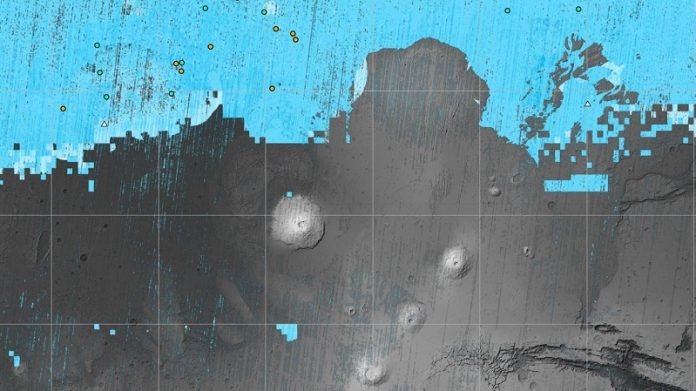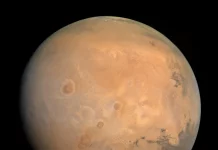
Water will be one of the most important resources for human explorers on Mars. They’ll need it for drinking, propellant, breathing, and more.
It makes sense to land near a spot where there’s water ice close to the surface.
NASA has released a new map of Mars’s northern hemisphere showing all the places where subsurface water ice has been detected, some of which are surprisingly close to the equator, as well as surprisingly close to the surface.
This map could decide the first human landing site.
Early on during the Mars Reconnaissance Orbiter (MRO) mission, which arrived at Mars in 2006, scientists started finding evidence of subsurface water ice being exposed from recent impacts, showing up as bright white in the high-resolution images from the new spacecraft.
While scientists were fairly certain there was ice below the surface at high latitudes of Mars, they were surprised to find that the ice was also present closer to the equator.
But whenever you’re looking for exposed subsurface ice on the Red Planet, you have to look fast. It doesn’t take long for ice — or water – to sublimate away because of the thin atmosphere on Mars.
Scientists have now combined data from several NASA missions, including MRO, 2001 Mars Odyssey, and the now-inactive Mars Global Surveyor. The project is called SWIM, Subsurface Water Ice Mapping. The project has just released its fourth set of maps, and NASA and JPL say these are the most detailed water ice maps since the project began in 2017.
See the interactive map here, where you can zoom in and explore the various regions where water ice could be buried.
Using a mix of data sets, scientists have identified the likeliest places to find Martian ice that could be accessed from the surface by future missions.
“These ice-revealing impacts provide a valuable form of ground truth in that they show us locations where the presence of ground ice is unequivocal,” said Gareth Morgan, SWIM’s co-lead at the Planetary Science Institute, in a JPL press release. “We can then use these locations to test that our mapping methods are sound.”
The new maps reveal what scientists believe are masses of subsurface frozen water along Mars’ mid-latitudes. The northern mid-latitudes are especially attractive because a thicker atmosphere exists there than most other regions on the planet.
A thicker atmosphere would aid in slowing down an incoming spacecraft. NASA says the ideal astronaut landing sites would be a sweet spot at the southernmost edge of this region – far enough north for ice to be present but close enough to the equator to ensure the warmest possible temperatures for astronauts in an icy region.
“If you send humans to Mars, you want to get them as close to the equator as you can,” said Sydney Do, JPL’s SWIM project manager. “The less energy you have to expend on keeping astronauts and their supporting equipment warm, the more you have for other things they’ll need.”
Back in 2009, data from several instruments on MRO detected and confirmed highly pure, bright ice exposed in new craters, ranging from 1.5 feet to 8 feet deep, at five different Martian sites. Scientists said they were able to figure out, given how long it took that ice to fade from view, that the ice was about 99 percent pure ice.
Over the years, MRO’s wonderful, high-resolution camera, HiRISE (High-Resolution Imaging Science Experiment) has continued to study fresh impact craters, where meteoroids may have excavated chunks of ice.
For the latest maps for the SWIM project, HiRISE data was incorporated to provide the most detailed perspective of the ice’s boundary line as close to the equator as possible. Another instrument on MRO, the Context Camera, which provides a big-picture, background view of the terrain, provides data that further refines the northern hemisphere maps.
In addition to ice-exposing impacts, scientists also look for “polygon terrain,” where the seasonal expansion and contraction of subsurface ice causes the ground to form polygonal cracks. Seeing these polygons extending around fresh, ice-filled impact craters is yet another indication there’s more ice hidden beneath the surface at these locations.
“The amount of water ice found in locations across the Martian mid-latitudes isn’t uniform; some regions seem to have more than others, and no one really knows why,” said Nathaniel Putzig, SWIM’s other co-lead at the Planetary Science Institute. “The newest SWIM map could lead to new hypotheses for why these variations happen.”
He added that it could also help scientists tweak models of how the ancient Martian climate evolved over time, leaving larger amounts of ice deposited in some regions and lesser amounts in others.
SWIM’s scientists hope the project will serve as a foundation for a proposed future mission, called Mars Ice Mapper. This would be an orbiter with a powerful subsurface radar that could search for near-surface ice beyond where HiRISE has confirmed its presence.
Follow us on Twitter for more articles about this topic.
Written by Nancy Atkinson/Universe Today.



